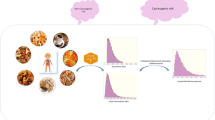Abstract
The present study reports the outcomes of assessment on acrylamide levels in selected heat-treated foods of diverse brands and origins from Saudi Arabia. In chips, acrylamide level was detected from 28 to 954 µg/kg, sample 7 (salted) contained higher amount (954 μg/kg) whereas, sample 8 (labneh and mint) comparatively produced lower amount (28 μg/kg). Nuts and dried fruits have generated acrylamide from 2 to 93 µg/kg, salted peanut of Indian origin produced higher amount (93 μg/kg) while apricot (plain) relatively generated lower amount (2 μg/kg). The levels of acrylamide in biscuits, pastry, cacao, chocolate, olive, cheese, corn, oat and wheat flakes, and bread were found from 26 to 234 µg/kg. Biscuits generated high concentration (234 μg/kg) while corn flakes fairly generated lower amount (26 μg/kg). The obtained results have shown a great variation of acrylamide content and reason might be due to foods type, cooking ingredients and, cooking methods, time and temperature.

Similar content being viewed by others

References
EPA. Environmental Protection Agency 749-F-94-005a: Chemical Summary for Acrylamide (1994).
Shipp A, Lawrence G, Gentry R, McDonald T, Bartow H, Bounds J, Macdonald N, Clewell H, Allen B, Van Landingham C. Acrylamide: Review of toxicity data and dose-response analyses for cancer and noncancer effects. Crit. Rev. Toxicol. 36: 481–608 (2006).
SNFA. Analysis of Acrylamide in Food, Swedish National Food Administration, (2002). http://www.slv.se/acrylamide.
WHO. Acrylamide in Drinking-Water. Background Document for Development of World Health Organization Guidelines for Drinking-Water Quality, Geneva, (2011). http://www.who.int/water_sanitation_health/dwq/chemicals/acrylamide.pdf (Retrieved November 20, 2016).
Donald SM, Bronislaw LW, Andrew TD. Food chemistry: Acrylamide is formed in the Maillard reaction. Nature 419: 448-449 (2002).
Richard HS, Imre B, Natalia V, Fabien R, Jörg H, Philippe AG, Marie-Claude R, Sonja R. Food chemistry: Acrylamide from Maillard reaction products. Nature 419: 449–450 (2002).
Klaunig JE. Acrylamide carcinogenicity. J. Agric. Food Chem. 56: 5984-5989 (2008).
Beland FA, Mellick PW, Olson GR, Mendoza MC, Marques MM, Doerge DR. Carcinogenicity of acrylamide in B6C3F(1) mice and F344/N rats from a 2-year drinking water exposure. Food Chem. Toxicol. 51: 149-159 (2013).
IARC. Acrylamide, in Some Industrial Chemicals. IARC Monographs on the Evaluation of Carcinogenic Risk of Chemicals to Humans, vol. 60. Lyon, France: International Agency for Research on Cancer, pp 389–433, (1994).
IARC. Acrylamide, in Some Chemicals Used in Plastics and Elastomers. IARC Monographs on the Evaluation of Carcinogenic Risk of Chemicals to Humans, vol. 39. Lyon, France: International Agency for Research on Cancer, pp 41-66, (1986).
EFSA. European Food Safety Authority, Draft scientific opinion on acrylamide in food (2014). http://www.efsa.europa.eu/en/consultations/call/140701.pdf (Retrieved November 20, 2016).
Olmez H, Tuncay F, Ozcan N, Demirel S. A survey of acrylamide levels in foods from the Turkish market. J. Food Compos. Anal. 21: 564–568 (2008).
FAO/WHO. Summary report of the sixty-fourth meeting of the Joint Food and Agriculture Organization & World Health Organization Expert Committee on Food Additives (2002). http://www.who.int/entity/ipcs/food/jecfa/summaries/summaryreport64final.pdf (Retrieved November 20, 2016).
EFSA. Results on acrylamide levels in food from monitoring years 2007–2009 and exposure assessment, Scientific Report of European Food Safety Authority Journal, 9: 2133. (2011).
Friedman M. Chemistry, biochemistry, and safety of acrylamide. A review. J. Agric. Food Chem. 51: 4504-4526 (2003).
Hoenicke K, Gatermann R, Harder W, Hartig L. Analysis of acrylamide in different foodstuffs using liquid chromatography-tandem mass spectrometry and gas chromatography-tandem mass spectrometry. Anal. Chim. Acta, 520: 207–215 (2004).
FDA. Survey Data on Acrylamide in Food: Individual Food Products. Food Drug Administration (2006). http://www.fda.gov/Food/FoodborneIllnessContaminants/ChemicalContaminants/ucm053549.htm (Retrieved November 1, 2012).
FAS. Foreign Agricultural Service (2015). http://gain.fas.usda.gov/Recent%20GAIN%20Publications/Exporter%20GuideRiyadh_Saudi%20Arabia10-1-2015.pdf (Retrieved November 20, 2016)
Wyka J, Tajner-Czopek A, Broniecka A, Piotrowska E, Bronkowska M, Biernat J. Estimation of dietary exposure to acrylamide of Polish teenagers from an urban environment. Food Chem. Toxicol. 75: 151–155 (2015).
Mesias M, Morales FJ. Acrylamide in commercial potato crisps from Spanish market: Trends from 2004 to 2014 and assessment of the dietary exposure. Food Chem. Toxicol. 81: 104–110 (2015).
Yusà V, Quintás G, Pardo O, Martí P, Pastor A. Determination of acrylamide in foods by pressurized fluid extraction and liquid chromatography-tandem mass spectrometry used for a survey of Spanish cereal-based foods. Food Addit. Contam. 3: 237-244 (2006).
Bermudo E, Moyano E, Puignou L, Galceran MT. Determination of acrylamide in foodstuffs by liquid chromatography ion-trap tandem mass-spectrometry using an improved clean-up procedure. Anal. Chim. Acta 559: 207–214 (2006).
Bermudo E, Moyano E, Puignou L, Galceran MT. Liquid chromatography coupled to tandem mass spectrometry for the analysis of acrylamide in typical Spanish products. Talanta 76: 389–394 (2008).
Biedermann M, Biedermann-Brem S, Noti A, Grob K, Egli P, Mandli H. Two GC-MS methods for the analysis of acrylamide in food. Mitt. Lebensm. Hyg. 93: 638–652 (2002).
Zhang Y, Jiao J, Cai Z, Zhang Y, Ren Y. An improved method validation for rapid determination of acrylamide in foods by ultra-performance liquid chromatography combined with tandem mass spectrometry. J. Chromatogr. A 1142: 194–198 (2007).
Murkovic M. Acrylamide in Austrian foods. J. Biochem. Biophys. Methods 61: 161–167 (2004).
JRC. Acrylamide Level Monitoring Database Overview of 5 years of data collection in Europe, Joint Research Centre, Institute for Reference Materials and Measurements (2008).
Ghiasvand AR, Hajipour S. Direct determination of acrylamide in potato chips by using headspace solid-phase microextraction coupled with gas chromatography-flame ionization detection. Talanta 146: 417–422 (2016).
De Paola, EL, Montevecchi G, Masino F, Garbini D, Barbanera M, Antonelli A. Determination of acrylamide in dried fruits and edible seeds using QuEChERS extraction and LC separation with MS detection. Food Chem. 217: 191–195 (2017).
Atwa MA, Emara MF, Hamza AS, Elmeleigy KM. Acrylamide levels in heat-treated Egyptian foods. J. Food Dairy Sci. 1: 69–84 (2010).
EC. European Commission recommendation of 10.1.2011 on investigations into the levels of acrylamide in food (2011). http://ec.europa.eu/food/safety/docs/cs_contaminants_catalogue_acrylamide_recommendation_10012011_food_en.pdf (Last accessed 29 September 2016).
Lineback DR, Coughlin JR, Stadler RH. Acrylamide in foods: a review of the science and future considerations. Annu. Rev. Food Sci. Technol. 3: 15–35 (2012).
Al-Dmoor HM. Determination of acrylamide levels in selected traditional foodstuffs and drinks in Jordan. J. Food Agric. Environ. 3: 77–80 (2005).
Acknowledgements
The authors are very thankful to the King Abdulaziz City for Science and Technology (KACST), Kingdom of Saudi Arabia for the financial support of this project (Project Number 193–35).
Author information
Authors and Affiliations
Corresponding author
Rights and permissions
About this article
Cite this article
Khan, M.R., Alothman, Z.A., Naushad, M. et al. Monitoring of acrylamide carcinogen in selected heat-treated foods from Saudi Arabia. Food Sci Biotechnol 27, 1209–1217 (2018). https://doi.org/10.1007/s10068-018-0358-5
Received:
Revised:
Accepted:
Published:
Issue Date:
DOI: https://doi.org/10.1007/s10068-018-0358-5



